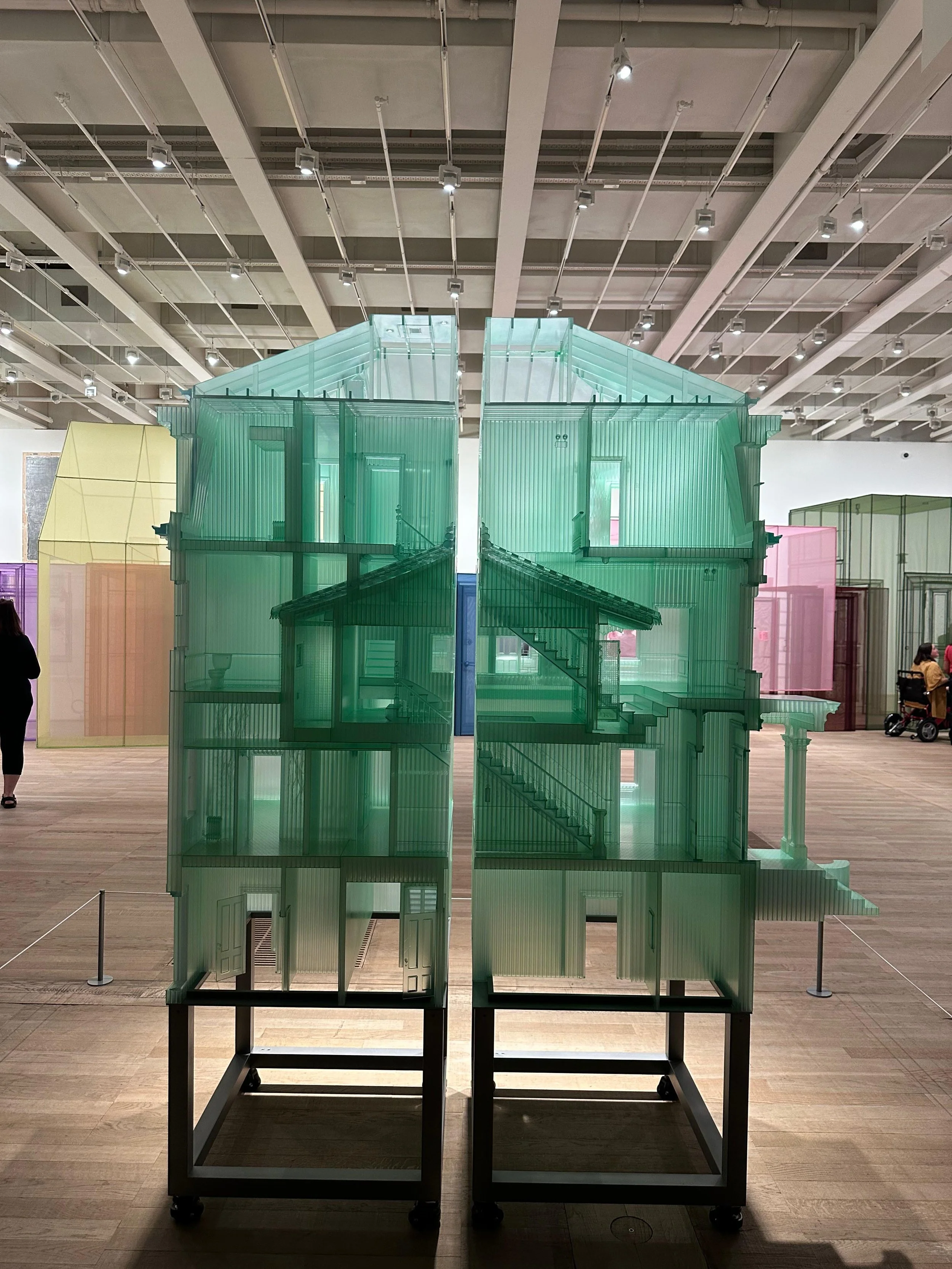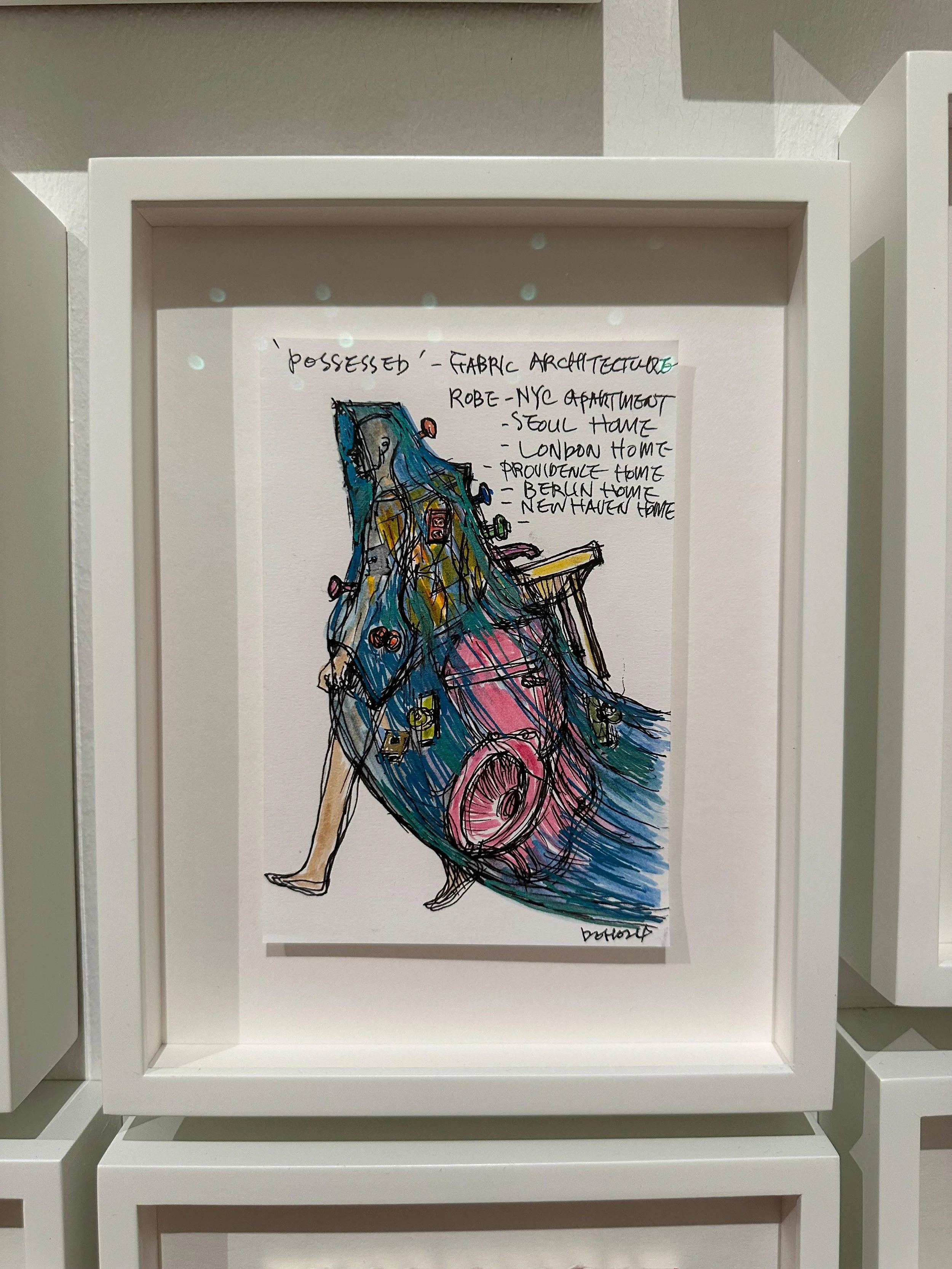How many homes can you carry in your heart?
This new London art show makes you notice the little things that make a home a home
Do Ho Suh, Haunting Home, 2019. Courtesy of the artist, Lehmann Maupin, New York, Seoul and London, Victoria Miro and STPI - Creative Workshop & Gallery. © Do Ho Suh
Tate’s exhibition Do Ho Suh: Walk the House brings together major works of a Korean artist intent on making sense of what identity means in the modern world.
What does your door mat say? Home Sweet Home, Welcome or maybe F-Off? What do we mean by home, is it a place or a feeling?
Do Ho Suh’s entire art practice is about trying to answer what home is for him. Installations, sculptures, videos, drawings – all are there to investigate his own and our relationship with spaces that we inhabit.
In this show, architecture is the opposite of what we typically think it is in the outside world.
First, several full-scale replicas of real spaces are transparent – not just the windows, but the walls, doors, fixtures and fittings. They’re more like undergarments than buildings. They would not protect you, hide you, give you comfort. But does architecture do that in the real world anyway?
Do Ho Suh, Perfect Home: London, Horsham, New York, Berlin, Providence, Seoul, 2024, installation view, The Genesis Exhibition: Do Ho Suh: Walk the House. Courtesy the Artist, Lehmann Maupin New York, Seoul and London and Victoria Miro. Creation supported by Genesis. © Do Ho Suh. Photo © Tate (Sonal Bakrania)
None of the works here are liveable. But all are based on places in which, at some point, the artist lived. Some are made of translucent fabrics, others of paper. They preserve the size and layout, but not the stability of the original buildings.
Other works seem more solid – made from 3D printed plastic – but they’re models, scaled down and not fit for human habitation.
All are somewhat dream-like. Have you ever dreamt of being in a familiar place where some things were not quite right, but you couldn’t tell what was real and what wasn’t? Do Ho Suh’s spaces are very much like that: they are amalgams of buildings, real and remembered.
Another hallucinatory state I’m thinking of is when I sleep at a new place and almost wake up, but for a moment can’t quite understand where I am, and the brain makes up logical solutions to this conundrum.
Usually it conjures composites of my home and this new place – exactly what Do Ho Suh does in Nest/s 2024.
Do Ho Suh, Nest/s, 2024, installation view, The Genesis Exhibition: Do Ho Suh: Walk the House. Courtesy the Artist, Lehmann Maupin New York, Seoul and London and Victoria Miro. Creation supported by Genesis. © Do Ho Suh. Photo © Tate (Sonal Bakrania)
Nest/s is a large-scale installation that brings together parts of various houses that Suh lived in while in Seoul, New York and London. Different colours of fabric are used for different parts, but they’re all sewn together – a physical metaphor for the artist’s experiences living in these spaces – experience that shaped who he is now.
In his case this means not only different houses, but different countries and cultures.
I tried to count how many ‘homes’ I lived in – it is somewhere around a dozen – and each left a mark. Even if you only move down the road, once you move, the dynamic of your surroundings changes – physical surroundings for sure, but also human – from your own family/group to neighbours and even passers-by.
Do Ho Suh, Home Within Home (1/9 Scale), 2025, Resin. Photo AT.
For Do Ho Suh, spaces that were at one point significant, remain so long-term. The artist does not believe in linear time, but rather in cycles of time.
He returns incessantly to places he once inhabited. His works allow him to give these returns physical expression. Would these places – that he himself created – also become part of his special vocabulary?
An oft-recurring reference in his works is the traditional hanok Korean house. Rubbing/Loving: Seoul Home saw the artist wrap it in paper and rub the pencil over it – painstakingly covering every corner and detail. The artist made a rubbed ‘copy’ of this house – a literal memory of the place that is itself a keeper of memories.
Do Ho Suh, Rubbing/Loving Project: Seoul Home, 2013-2022, installation view, The Genesis Exhibition: Do Ho Suh: Walk the House. Courtesy the Artist, Lehmann Maupin New York, Seoul and London and Victoria Miro. Repurposing supported by Genesis. © Do Ho Suh. Photo © Tate (Jai Monaghan)
The title of the exhibition, Walk the House, comes from the Korean expression, which refers to the inherently mobile nature of hanok houses – they can be disassembled and reassembled in a new place.
Would taking the house with you make the move any easier to bear? If you had a perfect home, you would never have to leave it; you could just take it with you.
But what is a perfect home? Everyone has their own image of one. What characteristics define it? The size, location, temperature, views? Maybe the people in it. Maybe the strength of the Wi-Fi signal.
Do Ho Suh’s perfect home seems anything but.
Do Ho Suh, Perfect Home: London, Horsham, New York, Berlin, Providence, Seoul, 2024 (detail), Polyester, stainless steel, 455 x 575 x 1237 cm, Courtesy the Artist, Lehmann Maupin New York, Seoul and London and Victoria Miro., Photography by Jeon Taeg Su, © Do Ho Suh
Perfect Home: London, Horsham, New York, Berlin, Providence, Seoul is a dizzying amalgamation of contradictions. Here a blank canvas of transparent fabric walls is scattered with sewn ghosts of switches and sockets located at the height of the originals from the artist’s homes of the present and the past.
Perfect Home brings together spaces that are architectural, but also psychological, that the artist inhabits now, and used to in the past, that are traditional and contemporary.
This constructed space seems very personal, but the people who were involved in the project – from the sewers to the planners – make it very much a collective one too.
According to the show’s co-curator, Dina Akhmadeeva, Do Ho Suh embraces collaboration. His studio members and a team of sewers (both in London and Korea) are integral to the creation of his works. Teams of architects model the space in advance. The sewers bring their expertise in making clothes to providing endless intricate details to the works.
The collaborative nature of the artist’s practice allows him to use a wide array of highly specialised techniques. From intricate sewing to 3D modelling and printing, from pencil rubbing to state-of-the-art mathematical software that allows precise space mapping. Futuristic technology meets traditional craft.
Do Ho Suh, Staircase 2016, installation view, The Genesis Exhibition: Do Ho Suh: Walk the House. Courtesy the Artist, Lehmann Maupin New York, Seoul and London and Victoria Miro. © Do Ho Suh. Photo © Tate (Jai Monaghan)
He does not stop at three-dimensional space either: in several works, space suddenly ceases to be. In one, the staircase is flattened and in another space becomes a layout. The videos use combinations of images superimposed or stitched with one another to create models of spaces.
In the final room, we are presented with yet another version of a ‘perfect home’ called Bridge Project. And it again seems anything but perfect. It’s a fantasy of an impossible, but realistic, construction that would sit in the middle of an ocean equidistant from the cities the artist holds most dear – Seoul, New York and London.
Like all other ‘spaces’ in the show, this one is less about the physical reality, and more about what homes are for, what they mean and represent. What an absence of home is. What a longing for home is.
Do Ho Suh, Possessed, 2024, ink on paper, Private Collection. Photo AT
I think this is the perfect show for London. Why? It’s a city of migrants. Only about a quarter of Londoners were born in the city, and while many moved from other parts of the UK, about 40 per cent came from other countries.
London is also a city of renters – the majority don’t own their home. Furthermore, hundreds of thousands of people leave London every year. It is a city constantly in flux.
But it is also home to very many people who, like me, would be reminded by this show of their own experience living in more than one place, carrying more than one home in their heart.
The Genesis Exhibition : Do Ho Suh : Walk the House is at Tate Modern from 1 May until 19 October 2025.









